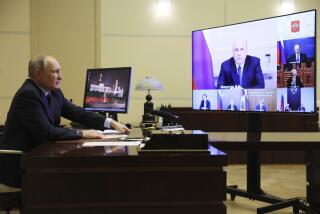Test-ban Cheaters Couldn’t Prosper : Sophisticated Monitoring Raises the Need for a New Debate
- Share via
The House of Representatives is about to vote on a resolution asking the President to reopen negotiations with the Soviet Union on a comprehensive nuclear test ban. The Reagan Administration does not want to stop testing and is lobbying intensively to defeat the resolution.
As usual, one of the Administration’s main arguments is that a ban on nuclear tests could not be adequately verified, and it is dredging up the same tired and discredited litany we have been hearing since the 1950s.
The argument goes like this: Small nuclear explosions are hard to distinguish from earthquakes, and the Soviets might cheat by exploding small weapons in large caverns or by trying to mask small nuclear blasts during actual earthquakes. One Administration lobbyist has even resurrected the old notion that the Soviets could hide a nuclear explosion behind the sun. Then there’s the charge that the Soviets have already violated the threshold test ban treaty and that they refuse to consider on-site inspection.
Every one of these arguments is false or misleading. Modern seismographs can detect earth motions smaller than one-thousandth the diameter of a single atom, and modern data processing equipment can combine the data from hundreds of seismographs to produce a distinctive “image” of an explosion or an earthquake down to energy releases corresponding to yields of one kiloton or less. This is especially true if we include the many seismographs that the Air Force Technical Applications Center has been placing on the ocean floor for many years and the unmanned stations that the Soviets have said they would allow to be deployed on their territory.
None of the cheating scenarios makes sense. There is no military reason to explode bombs smaller than one kiloton, and even if there was there would still be an unknown risk of detection. The Soviet Union is surrounded by a host of countries that have highly advanced seismological capability, and they would compete with enthusiasm to be the first to catch Moscow in a violation. Western Europe and Japan bristle with seismic observatories; Sweden and India are both strategically located and anxious to join a consortium of non-aligned nations that would monitor both Soviet and American tests, and China has a highly advanced seismological capability and every reason to watch the Soviets carefully. It’s a good rule of thumb that the closer one is to the Soviets, the less one trusts them. This rule happens to be ideal for the demands of seismic monitoring.
But if the Soviets did want to test small bombs in big cavities, they would first have to dig quite a hole. To fully “decouple” a five-kiloton explosion, they would need a cavern 250 feet in diameter and 3,000 feet underground. That would mean hauling away 300 trainloads of dirt and rock under the watchful eyes of U.S. satellites. And even a large cavity can’t muffle the high-frequency seismic waves to which newer seismographs are sensitive.
Trying to hide an explosion during an earthquake would be even more difficult. The Soviets would have to have their test weapon and instruments waiting for months or years, then fire on a moment’s notice. The seismic environment is not well enough understood to predict what the signal would look like at the hundreds of stations where it would be detected.
Testing behind the sun is the most bizarre scenario of all. The hundreds of millions of rubles each test would cost make $600 toilet seats seem like a bargain. One also wonders how the Soviets would explain all that interesting activity observed by U.S. space monitors.
On-site inspection of a comprehensive test ban is not necessary and is far more difficult, intrusive and inconclusive than is generally acknowledged. Even if one suspected that a secret test had occurred, hundreds of personnel carrying tons of equipment would have to spend up to a year drilling hundreds of deep holes over hundreds of square miles in some remote corner of Siberia and they would still probably end up with inconclusive results. Imagine the congressional debate if the Soviets were to ask us to let them do that in Idaho.
Finally, the Soviets have not cheated on the threshold test ban. A classified study commissioned by the Reagan Administration and leaked to the New York Times last November concluded that there is no case for Soviet violations, and that the threshold test ban treaty is adequately verifiable as it stands. President Reagan chose to ignore this study when he repeated his charges of violations last December.
A full national debate on the risks and benefits of a nuclear test ban is at least 30 years overdue. All this time we have allowed opponents of such a ban to blind us with a smokescreen of doubts about verification. Now it must be made absolutely clear once and for all: There are no doubts about verification. If we want a treaty to ban nuclear weapon tests we can verify it with high confidence.
More to Read
Sign up for Essential California
The most important California stories and recommendations in your inbox every morning.
You may occasionally receive promotional content from the Los Angeles Times.













